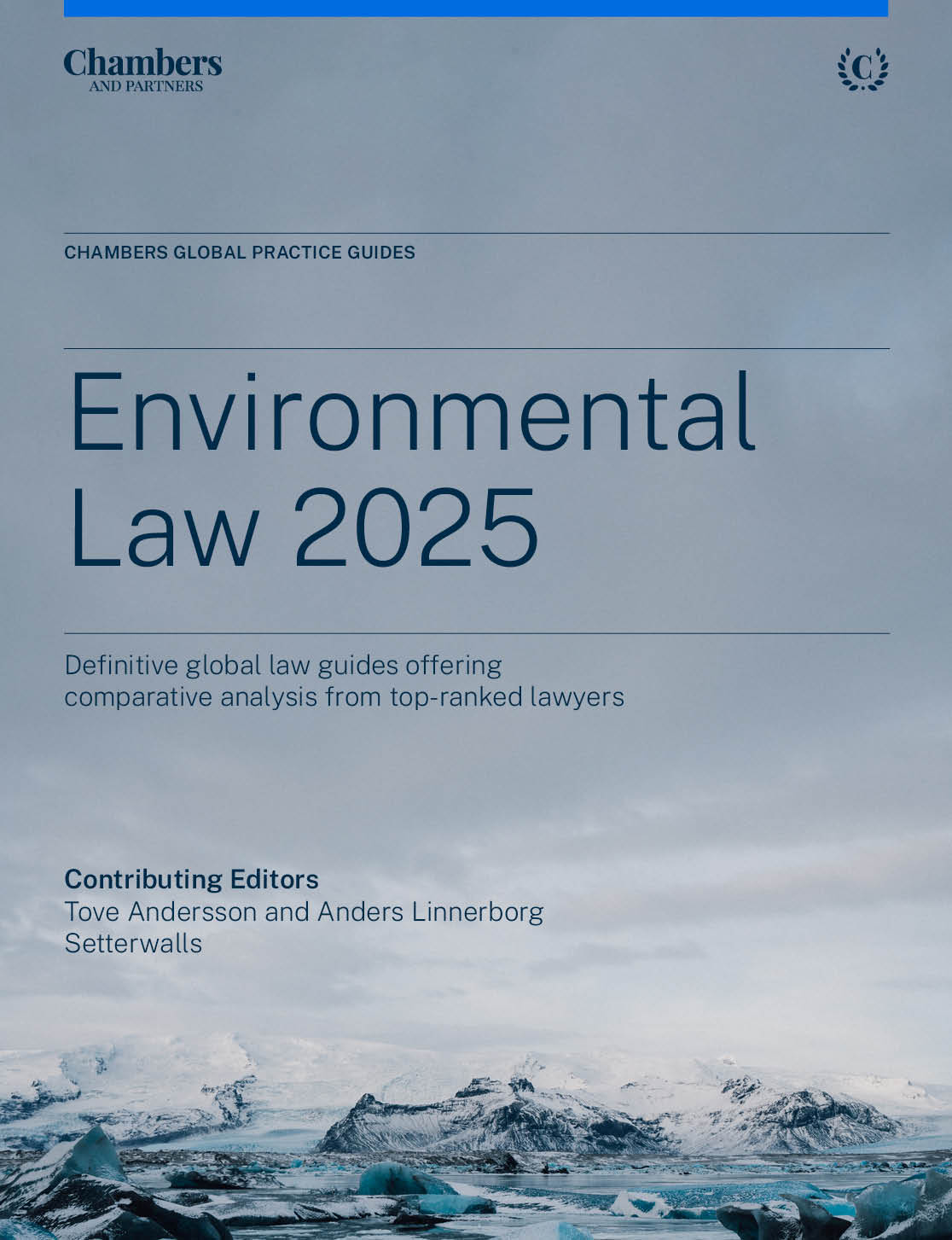
Environmental Law 2025
The Environmental Law 2025 guide features 25 jurisdictions. The guide provides the latest legal information on environmental policies and laws; regulatory authorities; environmental permitting, incidents, damages and liability (both corporate and personal); insurance; lender and civil liability; contaminated land; asbestos and PCBs; waste; climate change; environmental disclosure; and environmental due diligence.
Last Updated: November 27, 2025
Compare law and practice by selecting locations and topic(s)
Select Locations

Select Topic(s)

Please select at least one location and one topic to use the compare functionality.
Global Overview
The year 2025 has been marked by significant global events that have had profound implications for environmental law and policy. As predicted in the 2024 edition of the guide, the elections of 2024 have had a significant impact on environmental policy worldwide in 2025. Not least in the US, where several measures have altered incentives for climate action and sustainability, including the US second withdrawal from the Paris Agreement on climate change, the suspension of large renewable energy projects and the imposition of tariffs on primary materials, such as steel and aluminum, disrupting global value chains for clean technologies and affecting international trade more broadly.
Similar to the last three years, ongoing armed conflicts in Ukraine and Palestine have during 2025 continued to shape the environmental and energy landscape and not only caused immense human suffering but generated substantial environmental harm, including widespread pollution and long-term ecological damage. At the same time, numerous natural disasters and extreme weather events worldwide have brought devastating consequences for both humans and the environment.
To recognise and address climate change, there have been several efforts on a global level during 2025. Examples include the United Nations declaring 2025 as the International Year of Glaciers’ Preservation to raise global awareness about the critical role of glaciers in the climate system and the CBD COP16 reaching agreements on the implementation of the Kunming-Montreal Global Biodiversity Framework (KMGBF). At an EU level, the EU Commission has pursued a broad agenda to address climate change, promote sustainability and improve resource efficiency, reflected in a series of regulations, directives and ongoing negotiations. Examples include the Clean Industrial Deal, the Packaging Waste Regulation (PPWR) and the Chemical Industry Action Plan (CIAP), to name a few. At the same time, global energy innovation has continued apace, and major energy projects using various types of technologies have continued to be developed and operational during 2025.
While it is evident that 2025 has met resistance to climate action in some parts of the world, it can be concluded that sustainability and the climate remain critical and urgent global priorities and continue to spur innovation and regulatory development around the world. Some frequent themes that have recurred in relation to sustainability issues in 2025 include decarbonisation, waste management and biodiversity.
Development Concerning Decarbonisation and Clean Energy
Introduction
In 2025, discussions regarding renewable energy and the decarbonation of industries continued. While the US government has shifted its focus away from renewable energy, other large countries such as China and India have significantly increased their expansion of renewable energy sources such as solar and wind power. The European Commission has continued to have a clear focus on decarbonisation and developing renewable energy sources, including the adoption of the Clean Industrial Deal as well as issuing recommendations and guidance for EU member states to encourage innovative technologies and forms of renewable energy deployment. Changes have also been made to the EU day-ahead electricity trading markets, moving trading intervals from hourly to 15-minute intervals, making the markets more dynamic and equipped for the growing share of renewable energy.
It is clear that decarbonisation will require a portfolio of different measures on various levels. Over the past years, interest has grown in both cutting emissions and addressing those already released. Methods include both clean energy sources, including nuclear power, and CO₂ capture and storage solutions.
Nuclear power and small modular reactors (SMRs)
The increasing demand for electricity has made several governments and industrial stakeholders turn their attention to nuclear power, providing a stable form of low-emission electricity and reducing dependence on fossil fuels. Although an increased interest, significant regulatory and market barriers persist, including high costs and long permitting and construction timelines.
In the beginning of the year the IEA suggested that SMRs (see report, The Path to a New Era for Nuclear Energy), cutting the overall investment costs for individual projects, can play an essential role in change along with continued innovation and government support. Similar proposals have been made by the European Industrial Alliance on SMR, established in February 2024, which in September 2025 adopted its first Strategic Action Plan, including steps to simplifying regulatory frameworks. The European Commission is one of the key partners of the Alliance and in implementing the strategy. The Commission’s support to accelerate the development and deployment of SMRs has also been outlined in the Clean Industrial Deal, published earlier this year. Consequently, further policy and market initiatives concerning SMRs are expected in the years to come, not least in the EU.
Carbon dioxide capture and geological storage (CCS)
While discussing decarbonisation, technologies for CO₂ capture and storage should also be mentioned. As outlined in the Net-Zero Industry Act (NZIA), the EU has set a target of achieving a CO₂ injection capacity of at least 50 million tonnes per year by 2030. The regulation is designed to develop an EU market for CO₂ storage services and introduces obligations for hydrocarbon producers, EU member states and the European Commission.
Over the past year, the work with CO₂ storage has intensified in Europe. This is partly because, since December 2024, the member states of the EU are required to submit an annual report to the Commission detailing active CO₂ capture, transport and storage projects within their borders, along with the related needs for injection and storage capacity. They must also disclose any national support measures, strategies and targets adopted or planned for CO₂ capture. These reports are made publicly available by the Commission.
Regulatory Developments on Sustainability
The year 2025 marks notable advancements in the regulatory landscape concerning sustainability. The EU has introduced and updated several key regulations aimed at reducing waste, promoting circular economy principles and enhancing environmental resilience. On the international stage, efforts to address plastic pollution continue through ongoing United Nations negotiations.
Waste management
During 2025, waste has continued to be an important issue within the EU. The Packaging Waste Regulation (PPWR), replacing the PPWD, and the revision of the Waste Framework Directive to reduce textile and food waste are examples of new regulation which have been relevant during 2025. The PPWR entered into force in February 2025, harmonising rules for packaging, with a focus on secondary raw materials, manufacturing, recycling and reuse. The aim is to minimise the quantities of packaging and waste generated while lowering the use of primary raw materials and fostering the transition to a circular, sustainable and competitive economy. Most provisions will start to apply from August 2026.
During 2025, the European Commission has also taken measures to implement the Waste Shipment Regulation, adopted in April 2024, by developing a Digital Waste Shipment System (DIWASS) to simplify waste shipments between member states. The DIWASS is currently under development but will be mandatory to use for all intra-EU waste shipments, making the entire process fully digital, from 21 May 2026.
It is also worth mentioning that the UN negotiations that began in 2022 regarding a global agreement to combat plastic pollution have continued during 2025. However, after ten days of negotiation in August 2025 no consensus could be reached and the Intergovernmental Negotiating Committee (INC) agreed to resume negotiations at a future meeting.
Water resilience
While discussing sustainability, the European Commission’s new strategy for water resilience, presented 4 June 2025, is worth mentioning. The strategy has been developed in response to the problems and risks the Commission has identified regarding the Union’s water resources. In the strategy, the European Commission highlights factors that are expected to have increasing consequences for the Union’s inhabitants, economy and environment as extreme weather events become more common due to climate change.
The key objectives of the strategy include restoring and protecting the water cycle as the basis for sustainable water supply, building a water-smart economy and securing clean and affordable water and sanitation for all, and empowering citizens for water resilience. While the Commission concludes that the regulatory framework is already well developed, the strategy proposes and encourages additional measures and strategies to build water resilience. It is evident that the Commission views water resilience not only as a vital factor for a sustainable future but also as a source of business opportunities and an incentive for innovation.
The UN Water Conference will be held in the United Arab Emirates in December 2026. The conference will, among other things, address sustainable management of water and sanitation, as well as the water-related goals and targets of the 2030 Agenda.
EU Taxonomy disclosures
In discussions about sustainability, the revised EU Taxonomy is also worth mentioning. In June 2025, the European Commission adopted a set of measurements to simplify the application of the EU Taxonomy for Sustainable Activities, aiming to reduce the administrative burden for EU companies, thus enhancing EU competitiveness while preserving core climate and environmental goals. Given that the European Parliament and the Council do not have any objections, the simplification measures laid out in this Delegated Act will apply as of 1 January 2026 and will cover the 2025 financial year.
Stricter Rules for Chemicals
In July 2025, the EU Commission published its Chemical Industry Action Plan (CIAP) with the aim of modernising the chemical industry and strengthening its competitiveness. The action plan includes, among other things, measures to tackle challenges such as high energy costs, unfair global competition and low demand. Furthermore, the Commission aims to increase investment in innovation and sustainability. In this context it should be mentioned that there is an ongoing process of revising the Regulation on Registration, Evaluation, Authorisation and Restriction of Chemicals (REACH) with the aim of modernising chemical legislation. The EU Commission’s proposal is expected at the end of 2025.
Regarding chemical legislation it should also be noted that, at the end of 2024, the revised Regulation on the Classification, Labelling and Packaging of Chemicals (CLP) entered into force. Among other things, the Revised CLP ensures clearer chemical labelling, especially for online sales, and introduces simpler and clearer requirements to enable chemicals to move freely within the EU.
Summary
It has been a year of pronounced divergence and acceleration in environmental law and policy. Geopolitical developments, including the United States’ renewed withdrawal from the Paris Agreement and ongoing conflicts in Ukraine and Palestine, reshaped global climate incentives and exposed environmental vulnerabilities, while a series of extreme weather events underscored systemic risk. In parallel, multilateral processes advanced, with the UN spotlighting glacier preservation and COP16 operationalising the Kunming-Montreal Global Biodiversity Framework. The European Union sustained a comprehensive legislative agenda centred on decarbonisation, circularity and resilience, exemplified by the Clean Industrial Deal, the Packaging and Packaging Waste Regulation, and the Chemical Industry Action Plan. Energy policy prioritised diverse pathways: expanding renewables, renewed attention to nuclear including support for SMRs through the European Industrial Alliance and Commission initiatives, and scaling carbon capture and storage under the Net-Zero Industry Act’s injection capacity target alongside enhanced member state reporting. Waste and materials policy progressed through harmonised packaging rules and steps to digitalise intra-EU waste shipments, while global plastics negotiations remained inconclusive. Water resilience emerged as a strategic priority, with EU objectives spanning cycle restoration, water-smart growth, and access to clean, affordable water. Sustainable finance measures simplified EU Taxonomy disclosures to reduce compliance burdens, and chemicals regulation advanced via the revised CLP and forthcoming REACH reforms. Overall, despite headwinds, regulatory innovation and market initiatives continued to drive implementation across the EU and beyond.



